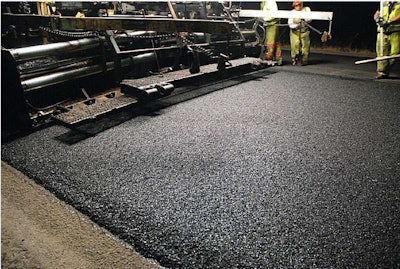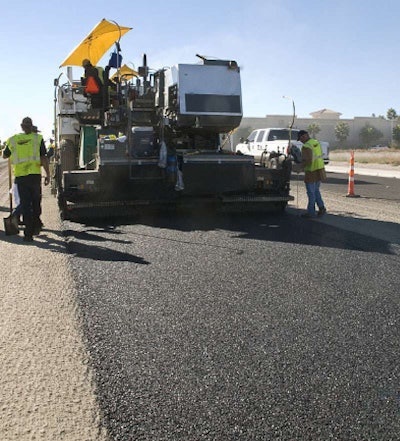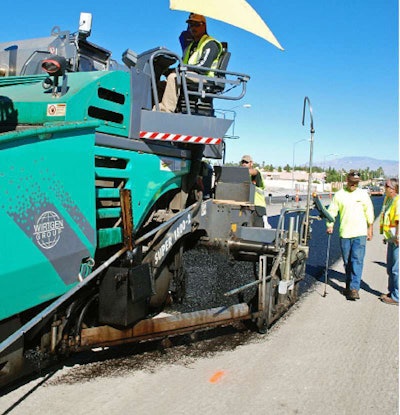Science Friction
Thin Open-Graded Surfacings Drive Market
By Tom Kuennen, Contributing Editor
Now, more than ever, thin open-graded friction courses (OGFCs) are driving the market for drainable, high-friction, noise-attenuating asphalt mixes.
 A thin crumb, rubber-modified, open-graded wearing course is placed on California Highway 1 near Fort Bragg; the mix incorporated a warm-mix additive to ensure workability, following the two-hour drive to the Pacific Coast from the plant.
A thin crumb, rubber-modified, open-graded wearing course is placed on California Highway 1 near Fort Bragg; the mix incorporated a warm-mix additive to ensure workability, following the two-hour drive to the Pacific Coast from the plant.This new generation of OGFCs is being bolstered by the advent of high-performance “spray” pavers that place thin, polymer-modified OGFCs quickly and with great consistency, and by new materials that halt the potential “draindown” of liquid asphalt within an open-graded mix.
The use of these new OGFCs also is expanding as a result of the general trend toward pavement preservation, as cash-strapped road agencies realize that it’s a lot cheaper to extend pavement life by spending limited funds on preservation techniques at the right time, rather than allow a road to deteriorate to the point of failure, with costly reconstruction the only option.
A conventional OGFC is a layer of asphalt that incorporates a skeleton of uniform aggregate size with a minimum of fines. It features an open aggregate structure in which larger-sized aggregate is held in place by polymer-modified and fiber-modified Superpave performance-graded liquid asphalts. Most OGFCs are 3/4-inch thick, and never thicker than 2 inches.
The OGFC’s open structure of 15 percent or more voids allows water to drain right through the driving or friction course to an impervious intermediate course below, and out into roadside ditches. The result is the near-complete elimination of tire spray and hydroplaning, making a safer pavement and saving lives. It also results in a quieter pavement as noise is attenuated within the gaps between the aggregate. OGFCs should be elevated above the shoulder, as the water drains onto the shoulder and hence to a roadside ditch.
A Variety of Names
Today’s spray-applied OGFCs are known by a variety of names. Oklahoma DOT has expanded the use of what it calls spray-applied ultra-thin bonded wearing courses. In Nevada, they’re known as ultra-thin asphalt concrete surfacings (UTACS, pronounced “you-tacks”), which are gap-graded wearing courses, bonded to the surface by a warm polymer-modified membrane, followed immediately by the hot, gap-graded, ultra-thin asphalt concrete friction layer.
UTACS are similar to Caltrans’ bonded wearing course, “a gap- or open-graded, ultra-thin hot-mix asphalt mixture applied over a thick polymer-modified asphalt emulsion membrane,” to quote the agency. “The emulsion membrane seals the existing surface and produces high binder content at the interface of the existing roadway surface and the gap- or open-graded mix, all in one pass.” Recently, Caltrans has been increasing its use of crumb rubber-modified emulsion for these OGFCs in lieu of polymer modifier.
Such bonded wearing courses are primarily used in high-traffic areas as a surface treatment over hot-mix asphalt or Portland cement concrete pavements. They are placed over structurally-sound pavements as a maintenance treatment, but may also be used in new construction and rehabilitation projects as the final wearing course.
In a bonded-wearing course such as those specified by Caltrans, a polymer-modified asphalt emulsion membrane seals the existing pavement while bonding the gap-graded or open-graded mix to the surface. The thicker nature of the membrane allows it to wick upwards into the mix, filling voids in the aggregate and creating an interlayer of high cohesion that does not delaminate or bleed, if applied correctly.
A predecessor of today’s thin, open-graded wearing course designs is NovaChip, an ultra-thin, bonded, gap-graded wearing course placed by a specialized paver in one pass. This exclusive pavement process applies an ultra-thin hot-mix wearing course over a polymer-rich asphalt emulsion. The process rapidly secures the lift to the existing surface and allows for minimal traffic delays. Originally developed by a French contractor, the patent for NovaChip is currently owned by Colas S.A. and is licensed for use in the United States by Road Science LLC of Tulsa.
But what’s not happening today is an increase in deeper-lift OGFCs. While most states that use them place OGFCs as thin asphalt lifts at 3/4-inch depth or less, the Oregon DOT has been placing 3/4-inch open-graded mixes in structural layers of 2 inches or more for about 30 years, reports Dr. Steve Muench, et. al., at the University of Washington-Seattle, in a June 2011 report for the Oregon DOT. He adds the Washington State DOT has used similar mixes since the early 1990s, although more sparingly. Due in part to the damage done to OGFCs by studded tires used in Oregon, the report recommends that use of 3/4-inch OGFCs be discontinued in the state (see below).
OGFCs for Cold Weather?
Typically, OGFCs tend to be confined to states without severe winters, as it’s perceived that water trapped within the drainable layer can expand and cause the open-graded layer to ravel, or create dangerous icing, leading to accidents.
One cold weather state, Wisconsin, recently looked at OGFCs as used and discontinued by northern-tier states and provinces, and received a recommendation that it not proceed.
“OGFC has historically not been used in Wisconsin due to concerns about its performance in a climate with a large number of freeze-thaw cycles,” says Richard E. Root, P.E., Root Pavement Technology, in his 2009 Wisconsin Highway Research Program report, Investigation of the use of Open-Graded Friction Courses in Wisconsin. “Questions also exist about the cost/benefit of these mixtures.”
The study’s primary objectives were to determine if the OGFC mixture could be successfully used in the Wisconsin climate. After a literature review that listed many northern-tier states that had started “new generation” OGFCs, but had since discontinued them, Root concluded that Wisconsin should avoid them.
“While the use of OGFC mixtures in warm southern climates has been successful, this pavement has not proven to have the same successes in the northern freeze/thaw environment,” Root says. “None of the states or Canadian provinces with climates that duplicate Wisconsin’s use OGFC mixtures. On a routine basis, it is recommended that Wisconsin should not currently build pavements with an OGFC surface.”
This summer, Oregon had reason to abandon OGFCs altogether. In June, a technical report – Open-Graded Wearing Courses in the Pacific Northwest: Final Report by Stephen T. Muench, Ph.D.; Craig Weiland; Joshua Hatfield and Logan K. Wallace of the Department of Civil and Environmental Engineering, University of Washington – suggested that use of the 3/4-inch open-graded hot-mix asphalt (previously referred to as “F-Mix”) be curtailed.
“The best estimated service life of [Oregon] DOT 3/4-inch open-graded HMA ranges from 14 years (< 5,000 ADT) down to seven years (> 100,000 ADT), which is less than comparable dense-graded mixes,” Muench and researchers wrote in June. “The primary mode of distress is raveling and studded tire wear. Reduced service life, along with uncertain and unquantified safety benefits and a possible greater risk of early failure lead to a recommendation to discontinue use of 3/4-inch open-graded HMA in Oregon as a standard surface mix.”
Open-graded wearing courses used elsewhere in this country are not likely suited for use by Oregon DOT, due to their susceptibility to studded tire wear, they say, and the writers don’t recommend their adoption. “If 3/4-inch open-graded HMA does continue in use,” the writers say, “recommendations are [to] quantify its benefits, restrict its use to low-traffic routes (< 30,000 ADT), recalibrate the state’s pavement management system’s expected life to be more in line with observed historical life, and require the use of a windrow pick-up machine or end-dump transfer machine when paving OGFCs.”
Download the new research at https://ntl.bts.gov/lib/41000/41300/41329/SPR680.pdf
Binder Modification Key
Open-graded friction courses have been used since 1950 in the United States to improve the frictional resistance of asphalt pavements, promote drainage of water from pavement and thus reduce tire spray, and reduce noise from the tire/pavement interface.
Spaces within the “open-graded” or “gap-graded” mix — and amounting to as much as 20 percent of the mix or more in some European mixes — help drain water and attenuate tire noise.
OGFCs are attaining a new popularity as states take a look at refined mix designs incorporating additives like polymer modifiers, rubber asphalt, fibers and hydrated lime. But it wasn’t always this way.
Prithvi S. “Ken” Kandhal and Rajib B. Mallick of the National Center for Asphalt Technology (NCAT) at Auburn University published a 1998 survey, Open-Graded Asphalt Friction Course: State of the Practice. The survey showed that, when these pavements were introduced in the 1950s, some states had problems with them. Improvements in OGFCs have made a vast difference. “These improvements have been achieved with the help of good design and construction practices,” they write.
The secret is modification of the asphalt binder. “A vast majority of agencies report good experience using modified asphalt binders,” Kandhal and Mallick say.
Georgia’s experience reflects the OGFC survey. “Early mixes used were very susceptible to premature failure due to weathering,” state Georgia DOT researchers in the DOT’s Progress in Open-Graded Friction Course Development, presented at the Transportation Research Board annual meeting in 1998.
Because of early problems, Georgia put a moratorium on OGFCs in 1982. Likewise, Washington State DOT tried smaller stone-sized (3/8-inch) mixes as thin (0.15-foot) wearing courses in the 1980s and early 1990s, but discontinued their use because of excessive studded tire wear problems.
 Porous asphalt pavement is similar to open-graded friction courses (OGFC) but is meant for static loads and environmentally-sustainable stormwater drainage. A mix for the parade ground at U.S. Marine Corps Recruit Depot at Parris Island, S.C., contained Evotherm warm-mix additive instead of fibers.
Porous asphalt pavement is similar to open-graded friction courses (OGFC) but is meant for static loads and environmentally-sustainable stormwater drainage. A mix for the parade ground at U.S. Marine Corps Recruit Depot at Parris Island, S.C., contained Evotherm warm-mix additive instead of fibers.But in the 1990s, Georgia developed a mix that incorporates a high degree of single-sized coarse aggregate, polymer-modified asphalt binder, stabilizing fibers and hydrated lime.
“This mix has been used extensively statewide since 1993,” the DOT reports. Now Georgia, pleased with its success, is urging other state DOTs to reassess OGFCs. “[Agencies] should reconsider the possibility of using this modified OGFC on high-volume-traffic facilities,” they say. “It is now Georgia DOT policy to use modified OGFC as the final ride surface on all Interstates and on state route projects that have daily traffic volumes exceeding 20,000 and are not in a reduced speed zone area.”
Modified vs. Standard Binders
After Georgia, use of polymer-modified — and more recently, rubber-modified — binders for OGFCs has become common. But the use of polymer or crumb rubber modifiers in OGFC binder may come at a cost: the ability of the pavement to drain water, at least in 4.75-mm nominal maximum aggregate size (NMAS) mixes.
That’s what Qing Lu, assistant professor, Department of Civil and Environmental Engineering, University of South Florida, and John T. Harvey, professor, Department of Civil and Environmental Engineering, University of California-Davis, say in their 2011 Transportation Research Board paper, Laboratory Evaluation of Open-Graded Asphalt Mixes with Small Aggregates and Various Binders and Additives.
Their paper is part of ongoing research to develop alternative asphalt surface mixtures that are quieter and durable without much sacrifice of safety, they say.
Five binder types (PG 64-16, PG 58-34PM, PG 76-22PM, asphalt rubber and PG 76-22TR) and two additives (hydrated lime and cellulose fiber) were selected for a 4.75-mm NMAS gradation, they write. A series of laboratory tests were conducted to evaluate their pavement surface performance-related properties, including acoustic absorption, texture, resistance to raveling, moisture sensitivity, permeability, friction, resistance to permanent deformation and resistance to reflective cracking.
“Results show that using polymer-modified or rubberized binders instead of unmodified binder in the 4.75-mm NMAS open-graded mixture reduces permeability,” they write, “but increases acoustic absorption, with the mixture containing asphalt rubber binder showing the most acoustic absorption improvement.”
Using asphalt rubber also can enhance the mix’s resistance to moisture damage or premature failure, raveling, rutting and potential resistance to reflective cracking. “There are also preliminary indications of friction improvement by replacement of conventional binder with asphalt rubber binder in the small-size aggregate open-graded asphalt mix,” Lu and Harvey say.
Rubber-Modified OGFC Binders
Rubber-modified binders for OGFCs now are seen on the west coast (California) and the east coast (South Carolina), as well as in the epicenter in Arizona.
 On Napa Valley’s Silverado Trail, a specialized paver places tack coat at the rate of 0.17 to 0.20 gallons per square yard in advance of rubber-modified open-graded friction course.
On Napa Valley’s Silverado Trail, a specialized paver places tack coat at the rate of 0.17 to 0.20 gallons per square yard in advance of rubber-modified open-graded friction course.Modified asphalt cement binder is required in OGFCs to prevent draindown of the binder and achieve the necessary level of adhesion and mix stability, reports the Asphalt Rubber Technology Service (ARTS) at Clemson University. “Although typically a polymer is used as the modifying additive to the asphalt cement binder, crumb rubber made from scrap tires may also be used as an alternative modifier,” according to the university.
The South Carolina rubber-modified open-graded friction course is placed 3/4- to 1-inch deep, with a crumb rubber content of 12 percent by weight of the liquid asphalt, or 0.85 percent by weight of the mix.
There, OGFC can be placed on either asphalt or concrete pavements, and it consists of roughly 93-percent crushed stone, 7-percent modified asphalt binder and a small amount of stabilizing fibers, Clemson’s ARTS says.
 A next-generation polymer-modified open-graded friction course is placed on a Clark County, Nev., street.
A next-generation polymer-modified open-graded friction course is placed on a Clark County, Nev., street.“Rubber-modified open-graded friction course has all the same advantages as polymer-modified OGFC,” ARTS says. “Compared to concrete and standard asphalt dense-graded pavements, it has significantly lower noise levels, it has less surface water in wet weather, and it is generally safer in wet weather due to the better visibility and decreased hydroplaning, resulting from the lack of surface water on the pavement surface.”
In addition to sharing all the advantages of OGFC with its polymer-modified counterpart, rubber-modified OGFC also costs slightly less than conventional polymer-modified OGFC, ARTS says, adding when used in OGFC, scrap tires can be used at a rate of approximately 1,000 tires per mile of two-lane pavement.
Fighting Draindown with Fibers
While modifiers will help keep liquid asphalt binder from moving within an open-graded mix, it still may puddle at the bottom of a haul truck, or settle lower in the lift of mix just placed. This “draindown” of asphalt seriously compromises the durability of OGFCs.
The problem of draindown of liquid asphalt is solved by use of fibers – typically cellulose, but also mineral filler – which are used to hold the binder in place.
 Tack coat eliminated: Movable bars spray polymer-modified emulsion tack coat in advance of thin-lift open-graded UTACS friction course in Clark County, Nev.
Tack coat eliminated: Movable bars spray polymer-modified emulsion tack coat in advance of thin-lift open-graded UTACS friction course in Clark County, Nev.While cellulose fibers are most often used, new research indicates that polyethylene fibers may do the same thing in OGFCs. In the technical paper Characterization of OGFC Mixtures Containing Reclaimed Polyethylene Fibers written by V.S. Punith, of the Asphalt Rubber Technology Service at Clemson University, and A. Veeraragavan, Department of Civil Engineering, Indian Institute of Technology, Madras, and published last year in the Journal of Materials in Civil Engineering, it was reported that polyethylene fibers derived from recycled low-density polyethylene (LDPE) tote bags performed in OGFC mixes.
Polyethylene fibers recycled from LDPE bags collected from domestic waste improved OGFC mixes without fibers, they say. “Draindown test results indicated that OGFC mixtures with polyethylene fibers can be effectively used to retard draindown of the binder and mineral filler,” they write. “[T]est results indicated that OGFC mixtures with reclaimed PE fibers showed improvement in tensile strength and improved resistance to permanent deformation, fatigue-induced damage, and moisture susceptibility, when compared with mixtures without fibers.”
Draindown in Porous Mixes
While porous asphalt pavements are open-graded to encourage water drainage, they differ from open-graded friction or wearing courses by structure and function. Yet, they pose many of the same challenges as OGFCs, including binder draindown.
Porous asphalt pavement is an environmentally-sustainable infrastructure design that helps property owners manage stormwater effectively and inexpensively. They are specified for static traffic areas such as parking lots, and aren’t suitable for wearing courses.
Typically, a porous asphalt pavement will be composed of, from the bottom, an uncompacted soil subgrade that will optimize infiltration of water into the aquifer; a geotextile fabric that will permit water to pass but preclude movement of fines up into the structure; a stone recharge bed with same-sized aggregate and 40 percent voids; an optional stabilizing or “choker” course of single-size crushed stone smaller than that in the recharge bed; and an open-graded asphalt surface with 20-percent voids that permit stormwater to flow through the pavement into the stone recharge bed.
While OGFCs shoot for voids of 15 percent to control spray and noise, porous asphalt pavements let water drain directly into a recharge layer below, and the air-void target is 20 percent. The porous asphalt “green grinder,” or parade ground, constructed at the U.S. Marine Corps Recruit Depot at Parris Island, S.C., in May 2011 was not intended to reduce spray, hydroplaning or noise, but simply to provide the most efficient means of draining water from the paved surface and into the soil, while avoiding conventional detention ponds.
While fibers conventionally are used to stabilize porous asphalt mixes, an innovative warm-mix asphalt design for Parris Island saved money by eliminating fibers required for stability of the open-graded mix. The porous asphalt design also eliminated the expense of creating a detention pond and associated environmental requirements.
The elimination of fibers from the Parris Island mix was achieved by use of a warm-mix asphalt additive, Evotherm 3G from MWV Asphalt Innovations, which adds lubricity to individual microscopic asphalt particles, permitting production of asphalt at significantly lower temperatures than conventional mixes.
Evotherm stops the draindown of liquid asphalt by virtue of the lower mixing temperature it enables. “We were able to make the mix at 285 degrees F, instead of 350 degrees, which completely eliminates the problem of draindown,” says Dean Frailey, business development manager, MWV Asphalt Innovations. The mix was emerging from the truck at approximately 275 degrees and from the screed at about 245 degrees. No liquid asphalt was visible in the truck bed as mix was fed to a material transfer vehicle ahead of the paver.
CRM Binder in California
Crumb rubber-modified binder was used recently for an ultra-thin, open-graded wearing course in California’s Napa Valley. In the town of Napa, a 10-year-old asphalt overlay on the Silverado Trail was showing signs of wear over a 2.9-mile section. There was minor cracking, some raveling and a few areas required full-depth asphalt patching. But for the most part, the road was in good shape; it was structurally sound.
To preserve the road and extend its life, Caltrans turned to an ultra-thin bonded wearing course. In this process, a Roadtec SP-200 paver sprays a tack coat down just in front of the spreading augers, and the screed levels off a 3/4- to 1-inch-thick layer of open-graded hot mix.
On California Highway 50 between Placerville and South Lake Tahoe, an ultra-thin bonded wearing course lasted seven years, says Brian D. Toepfer, maintenance engineer, Caltrans. “I think it [performs] better than a mill-and-fill, and it is a lot less expensive.”
On the Silverado Trail, the Construction Division of Telfer Oil, Martinez, Calif., used the specially-equipped paver to spray down a heavily polymer-modified emulsion at a rate of 0.17 to 0.20 gallons per square yard. “The emulsion is similar to a PMCRS-2H emulsion, which is a standard chip sealing emulsion,” says Karl Meyers, general manager of Telfer’s Construction Division.
The paver immediately followed the emulsion with a 7/8-inch-thick layer of open-graded hot mix made with PG 64-16 liquid asphalt that was modified with crumb rubber. The target value for binder content was 8.5 percent, and the top-size aggregate in the mix was 3/8 inch. It also contained a small amount of sand.
Static compaction with two double-drum rollers followed the paver. “You have to run two rollers because you need to hit the temperature range on compaction, which is 180 to 280 degrees,” Meyers says. “That thin lift behind the screed is cooling fast, and you want to release the road to traffic quickly. Plus, the paver is moving at 70 to 100 feet per minute, so you need to run two rollers behind.”
The process has a number of advantages, Meyers says. “You are not getting any tack coat dragged around the city, you get an outstanding bond with the hot mix, you are forming a waterproof membrane, there is no water splash, and you can release the road quickly to traffic,” he says.
Polymer-Modified UTACS
In the meantime, a specialized paver has given a Las Vegas asphalt contractor entry into the growing market of ultra-thin asphalt concrete surfacings in Nevada and throughout the Southwest.
However, to correctly place UTACS or other bonded wearing courses, the right kind of paver is needed: One that has the ability to spray asphalt emulsion onto a pavement, and then immediately place a thin overlay on top. Las Vegas Paving found the Super 1800-2 with optional SprayJet module from Vögele fit the bill.
With its new Super 1800-2 SprayJet paver, Las Vegas Paving now is able to undertake pavement preservation contracts as agencies like Clark County, Nev., use available funds to prolong the life of pavement structures in its desert locale.
Las Vegas Paving acquired its Super 1800-2 SprayJet in early 2010, and has been using it for UTACS ever since. “We were the new kids on the block with this process,” says Clark Webster, general superintendent. “2010 was our first year paving UTACS, and we were concerned that interest would not last, but agencies are still interested.”
Late in 2010, Las Vegas Paving was applying a UTACS to busy Jones Avenue between Tropicana Avenue and Russell Road for the Clark County Department of Public Works. This 2,700-ton job involved three lanes each way, including shoulders and turn pockets. “Jones Avenue is a piece of a larger contract we have with the county, with each piece being anywhere from 15,000 to 20,000 square yards of UTACS,” Webster says. “Jones was a 1-inch deep UTACS, with almost 100-percent passing 1/2-inch with some fines.”
On Jones, warm polymer-modified emulsion was being sprayed directly ahead of the screed via spray bars on each side of the Super 1800-2 SprayJet at a rate of 13/100-gallon per square yard. “It’s not unlike a prime or tack coat, but it provides much more coverage,” Webster says. “And no one can run on it. The Super 1800-2 places the coat behind the wheels but ahead of the material, so cars or our haul vehicles can’t drive over it and pick up the sticky, polymer-modified emulsion. It gives us the best of both worlds – we are able to use a polymer-modified emulsion without having the mess of tires tracking it everywhere.”











